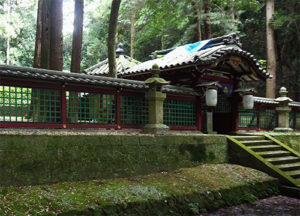


戦国末期の紀州で独立的な地域権力を誇り、僧兵1万、近代兵器鉄砲で重武装した
なんとも異形の「宗教集団」根来寺を見てきました。
わたしの家が真言宗であることは記述しましたが、その類縁として
こういった宗派が存在したことがかなり遠い印象しかもてない。
宗祖・覚鑁さんは高野山で宗教上のトップに立ったけれど、
そこで他の多くの僧侶達が腐敗堕落している状況に怒りを覚え、
どんどんと宗教的純粋化の「改革」を推し進めたとされる。
たぶん相当の「痛み」を他者に遠慮会釈なく強制したのでしょう。
それに対して守旧派僧侶たちが反発しついには覚鑁の本拠を焼き討ちしたという。
焼き討ちされた覚鑁は「無言の行」をもって批判した。
そして高野山改革を諦め根来寺の初源になる寺院に入っていわば別居を始めた。
こういった開祖の経緯がこの宗派の個性としてきわどく刷り込まれたのか。
やがて寺領を守るために僧兵で武装し、雑賀との相互浸透で鉄砲武装も進めた。
そういうなかでごく世俗的な政治的合従連衡を推し進めたという。
信長の天下布武軍事制圧には協力しつつ、次代の秀吉政権に対しては
反秀吉として小牧長久手で徳川氏に与力した。見返りも期待し合力したのだろう。
秀吉の専制的武家独裁政権が成立したときに、
最後の抵抗を見せた存在がこの根来寺勢力だったのでしょう。
というか、紀州一国があげて反政権の巣窟になっていた。
こうした動きには宗教勢力というよりも世俗そのものを見る思いがする。
なまじ仏法を語るだけ魔物に取り憑かれるような奇怪な印象。
宗教というよりも、武力権力の一形態というような印象がやはり強い。
排他性の強いこういう勢力は今日の共産主義ともアナロジーを抱く。
唯我独尊という存在ほど他者にとって危険極まりない存在はないだろう。
歴史としては本願寺が信長政権によって粉砕されその後残った武装宗教が
すべて解体されたというのが日本史の方向であり日本人の選択だった。
そういった勢力にして建築的には1100年代〜1400年代の形式を一部残し、
その後、徳川の世に至って武装解除された宗派として存続復興を図ってきた。
写真の「興教大師」覚鑁の眠る墓域の奥の院などは
江戸期の再興された根来寺としての建築痕跡だと言えるのでしょう。
なんとなく江戸期的なしつらいが各所に垣間見える。
武家専制政権は信長や秀吉の権力から徳川に移行したけれど、
より政治的に進化した支配体制を構築したのが徳川政権だったのでしょう。
本願寺勢力を東西2つに分割するなど観念至上主義勢力に対してその基本性向の
「内ゲバ体質」を巧妙に利用して統治した知恵の深さを思い知らされる。
若い時期の家康は一向一揆の怖さを十分に体験していた。
今日に至る日本人のDNAには、こうした戦国期の宗教勢力の自己崩壊・破綻が
色濃く学習効果を持っているように思えます。
English version⬇
[Japanese DNA-like dislike of criticism of others Kishu Negoroji-12]
Boasting independent regional power in Kishu at the end of the Warring States period, he was heavily armed with 10,000 monks and modern weapon guns.
I have seen a strange “religious group”, Negoroji.
I mentioned that my house is a Shingon sect, but as a relative
I have the impression that the existence of such a sect is quite distant.
Kakuban, the founder of the sect, was at the top of the religion on Mt. Koya,
There, many other monks became angry at the corrupt and corrupt situation.
He is said to have steadily promoted the “reform” of religious purification.
Perhaps he forced others to “pain” without hesitation.
On the other hand, the old priests rebelled and finally burned down the base of Kakuban.
Kakuban, on the other hand, criticized it with “silent deeds.”
And he gave up the reform of Mt. Koya and started to separate if he entered the temple that became the first source of Negoroji.
Was this background of the founder imprinted as the individuality of this sect?
Eventually, he was armed with monk soldiers to protect the temple territory, and he also advanced gun armament through mutual penetration with Saika.
Under such circumstances, he promoted a very secular political coalition.
While cooperating with Nobunaga’s military suppression of Tenka Fubu, against the next Hideyoshi administration
As an anti-Hideyoshi, he helped Mr. Tokugawa with Nagakute Komaki. Probably they expected a reward and worked together.
When Hideyoshi’s tyrannical samurai dictatorship was established
The existence that showed the last stand was probably the Negoroji power.
Rather, Kishu Ichikuni was the den of the anti-government.
I feel that these movements look at the world itself rather than the religious forces.
A bizarre impression that you are obsessed with monsters just by talking about the Buddhist method.
The impression that it is a form of armed power rather than religion is still strong.
These highly exclusive forces have an analogy with today’s communism.
Nothing is more dangerous to others than the existence of Yuigadokuson.
In history, the Honganji Temple was shattered by the Nobunaga administration, and the armed religion that remained after that
It was the direction of Japanese history and the choice of the Japanese that everything was dismantled.
Architecturally, with such a force, some of the styles of the 1100s-1400s were left behind.
After that, it has been trying to survive and reconstruct as a disarmament sect in the world of Tokugawa.
In the photo, “Kokyo Daishi” Kakuban’s sleeping grave area, Oku-no-in, etc.
It can be said that it is an architectural trace as a revived Negoroji temple in the Edo period.
Somehow, the Edo period’s hardships can be glimpsed in various places.
The samurai tyranny shifted from the power of Nobunaga and Hideyoshi to Tokugawa,
Perhaps it was the Tokugawa administration that built a more politically evolved rule system.
The basic tendency of the power of the idea supreme principle, such as dividing the power of Honganji into two, east and west.
You will be reminded of the depth of wisdom that you ruled by skillfully using the “Uchi-geba constitution”.
When Ieyasu was young, he fully experienced the fear of Ikko-ikki.
In the DNA of the Japanese people to this day, the self-destruction and collapse of religious forces during the Warring States period
It seems to have a strong learning effect.
Posted on 11月 25th, 2021 by 三木 奎吾
Filed under: 住宅マーケティング, 日本社会・文化研究







コメントを投稿
「※誹謗中傷や、悪意のある書き込み、営利目的などのコメントを防ぐために、投稿された全てのコメントは一時的に保留されますのでご了承ください。」
You must be logged in to post a comment.